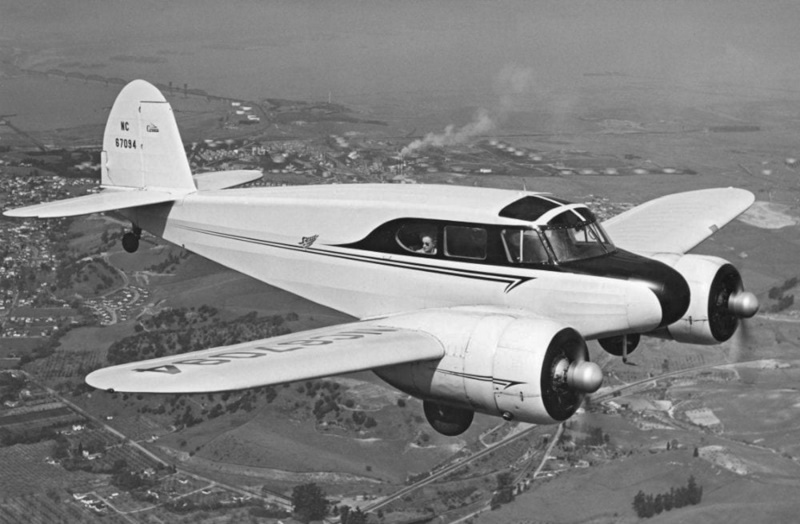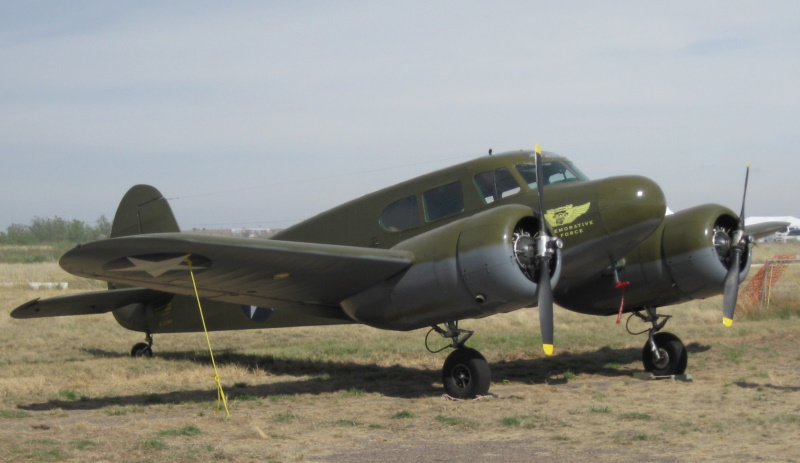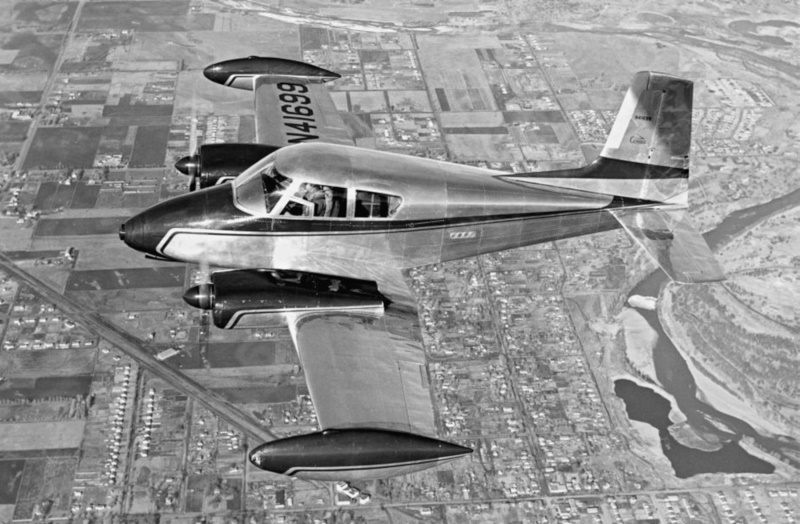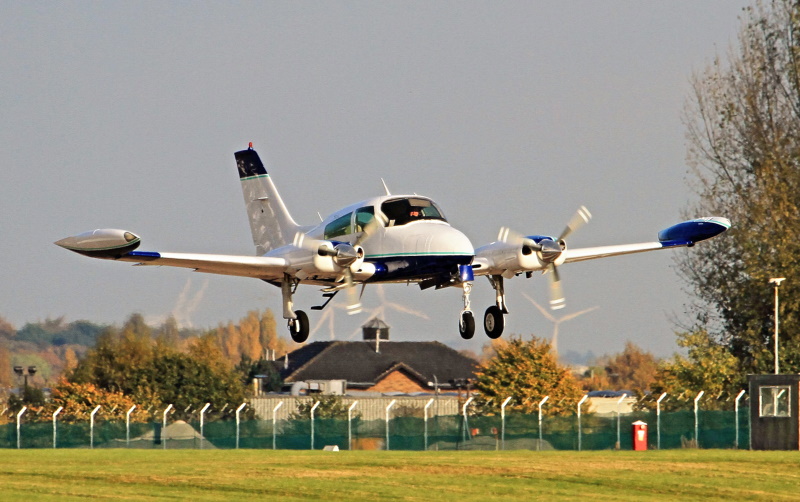
* In the prewar period, the Cessna Aviation Company of Wichita, Kansas, developed a twin-piston light transport, the "Model T-50", which would be produced in quantity during World War II, establishing Cessna as a major aircraft manufacturer. After World War II, Cessna followed up the T-50 with a much improved light transport, the "Model 310", with was also produced in quantity. This document provides a history and description of the Cessna T-50 and 310 -- as well the "Model 340 / 335" and "T303 Crusader" follow-ons to the Cessna 310. A list of illustration credits is included at the end.
* The Cessna aircraft company had struggled along during the 1930s, churning out new and improved aircraft designs while barely staying afloat financially. Seeking an opportunity, the company developed its first twin-engine aircraft, the "Model T-50", with first flight of the prototype on 26 March 1939. It was intended as a lightweight, low-cost alternative to competing twins like the Beech Model 18.

The T-50 was a low-wing aircraft with twin radial engines and taildragger landing gear, of mixed construction:
Flight control surfaces were conventional -- ailerons, one-piece trailing-edge flaps, elevators, rudder, trim tabs -- all surfaces being manually actuated, except for electrically-driven flaps. There were two bucket seats in front, and a bench seat for two or three in the back, with a baggage store behind the bench seat. There was a single forward-hinged door on the left of the cockpit, accessed by clambering up the wing, and a forward-hinged baggage door on the left as well, to the rear of the wing. Dual controls were standard.
The main gear semi-retracted up into the nacelles, helping to minimize damage on a "wheels-up" landing. The landing gear was electrically actuated, with a manual crank backup. The T-50 was powered by twin Jacobs R-755 air-cooled radial engines with 185 kW (245 HP) take-off power each, driving two-bladed fixed-pitch wooden propellers. There was a fuel tank in each inboard wing, with a maximum capacity of 227 liters (60 US gallons) each -- apparently, the practical capacity was less than that -- and eventually, some machines would have a 114-liter (30 US gallon) auxiliary fuel tank under the rear seat.
It is not clear how many commercial T-50s were built; tinkering with production totals suggests the number was 63 aircraft. Production of the T-50 would be overwhelmingly for military use. 640 T-50s were obtained by the Royal Canadian Air Force (RCAF) as the "Crane I", to be use as multi-engine trainers / light transports. They were predominantly flown in the British Commonwealth Air Training Plan, in which flight training for British forces was performed in Canada.
The US military would be a much bigger customer, with the Army Air Corps ordering a total of 33 in 1940 for evaluation as the "AT-8". The AT-8s were powered by Lycoming R-680-9 radial engines with 220 kW (295 HP) each, the Air Corps believing they should have more powerful engines. Following the AT-8 trainer, the engines reverted to the lower-powered Jacobs R-755 engines -- the Air Corps having changed their minds, the lower-power engines being seen as adequate for the training role. The aircraft was redesignated "AT-17", to be nicknamed in service as the "Bamboo Bomber" for its wood construction. It was docile and pleasant to fly, though it steered on the ground with differential braking, which flight cadets sometimes found difficult to master.
_____________________________________________________________________
CESSNA AT-17:
_____________________________________________________________________
wingspan:
12.78 meters (41 feet 11 inches)
wing area:
27.4 sq_meters (295 sq_feet)
length:
9.98 meters (32 feet 9 inches)
height:
3.02 meters (9 feet 11 inches)
empty weight:
1,590 kilograms (3,500 pounds)
MTO weight:
2,750 kilograms (6,060 pounds)
maximum speed:
315 KPH (195 MPH / 170 KT)
cruise speed:
280 KPH (175 MPH / 150 KT)
service ceiling:
6,700 meters (22,000 feet)
range:
1,205 kilometers (750 miles / 650 NMI)
_____________________________________________________________________
450 baseline AT-17s were built, followed by refined variants:
The AT-17D was the last trainer variant of the type built. Many AT-17s were eventually redesignated "AT-17E" -- a puzzling exercise, since it appears the only distinction between the two variants being that the AT-17E's maximum take-off weight (MTOW) was limited to 2,400 kilograms (5,300 pounds). It doesn't appear there were any changes to the aircraft itself. The AT-17A similarly became the "AT-17F", and the AT-17B became the "AT-17G".
In 1942, the US Army Air Forces (USAAF), which had superseded the Air Corps, having ordered more AT-17s than were needed for training requirements, began to obtain the T-50 for the light transport / utility role as the "C-78", to be redesignated "UC-78" in early 1943. It was effectively identical to the baseline AT-17s, with some minor changes in kit; 1,354 UC-78s were built, with 17 civilian T-50s also impressed into service under the designation of "UC-78A". The UC-78 was given the name "Bobcat", which effectively became the name of the entire T-50 line. 67 of them were transferred to the US Navy, being redesignated "JRC-1".
The UC-78 was followed by the "UC-78B", which was the AT-17B with transport kit, 1,806 being built; and the "UC-78C", which was the AT-17D with transport kit, with 196 built and 131 AT-17Ds converted -- both variants retaining wooden propellers, it appears as a resource-conservation measure.
Along with the production Bobcats, in 1941 Cessna flew two experimental variants of the T-50, neither of which went beyond a single prototype:
The last Bobcats were rolled out in 1944, total production being 5,422 aircraft, including:
Along with training and utility use, some Bobcats were used by operational squadrons as "hacks" -- though it was a kiddie-car ride for pilots used to flying high-performance combat aircraft, and got the nickname of "Useless 78". Most of the Bobcats were withdrawn from service after World War II, with those few that survived formally withdrawn in 1949.

After the conflict, many Bobcats were de-militarized and sold cheap for use on the civil market. They were used by private pilots, charter operators, and small airlines, with some of them fitted with floats. Foreign operators during the war, aside from Canada, included Brazil, Free France, and Haiti; it was also flown after the war by Costa Rica, Ethiopia, Guatemala, Nationalist China, Nicaragua, and Peru. Dozens of refurbished machines are still flying in the 21st century.
BACK_TO_TOP* Although the Bobcat had established Cessna as a going concern, the company didn't come up with a new-design twin until the early 1950s -- with the prototype of the "Model 310" performing its initial flight on 3 January 1953, with deliveries to customers in 1954.

The Cessna 310 was a big advance over the Bobcat, reflecting "lessons learned" since the prewar period. It was a sleek, low-wing aircraft, of all-metal construction, with tricycle landing gear, all gear having single wheels, the main gear electrically retracting inward towards the fuselage, the steerable nose gear retracting backward. The Cessna 310 had innovative features, such as "thrust augmenter" engine exhausts, and fuel stowed in wingtip tanks -- each tank with a capacity of 190 liters (50 US gallons). The tanks would become known as "tuna tanks" because of their fish-like profile, being flattened on the sides.
Flight control surfaces were conventional, including ailerons; split flaps, hinged under the rear wing, instead of behind it as with the Bobcat; elevators and rudder; plus trim tabs. All control surfaces were manually actuated, except for the electrically-actuated flaps. The Model 310 was powered by twin Continental O-470-B flat-six air-cooled engines, with 180 kW (240 HP) each, later production featuring the modestly-refined O-470-M engine variant. They drove two-bladed, constant-speed props. Dual controls were standard.
Passenger accommodations were similar to those of the T-50, with access to the cockpit via a single front-hinged door in front -- on the right, not on the left as with the T-150 -- with a step structure to allow pilot and passengers to get up on the wing. The steps retracted along with the landing gear, tucking up into a recess in the aircraft's belly. There were twin bucket seats and a bench seat in back; it could normally carry four passengers, though three small kids might be crammed into the back. Later on, four bucket seats would be more the norm, but it's difficult to know exactly when that happened. There was baggage storage behind the rear seat, accessible from the cockpit, and from a front-hinged door on the right side of the fuselage -- not on the left, as with the T-50. 547 baseline Model 310s were built to 1957.
_____________________________________________________________________
CESSNA MODEL 310:
_____________________________________________________________________
wingspan:
10.67 meters (35 feet)
wing area:
16.3 sq_meters (175 sq_feet)
length:
8.23 meters (27 feet)
height:
3.2 meters (10 feet 6 inches)
empty weight:
1,295 kilograms (2,850 pounds)
MTO weight:
2,090 kilograms (4,600 pounds)
maximum speed:
355 KPH (220 MPH / 190 KT)
cruise speed:
330 KPH (205 MPH / 180 KT)
service ceiling:
6,100 meters (20,000 feet)
range:
1,610 kilometers (1,000 miles / 870 NMI)
_____________________________________________________________________
In 1957, the US Air Force ordered the Cessna 310 for the liaison-utility role, obtaining 160 "Model 310A" machines, generally similar to the baseline Model 310 with the O-47-M engine, with MTOW raised to 2,190 kilograms (4,830 pounds) and designated "U-27A". They were given the nickname of "Blue Canoe", with the designation changed to "U-3A" in 1962, when the US armed services went over to a common designation scheme. The Air Force would deploy U-3s to Southeast Asia during the Vietnam War, using them for courier flights between air bases. Some Air Force U-3s were transferred to the US Army and Navy. The US military 310s served into the 1970s.

Refined variants followed, with Cessna introducing a new model every year, imitating automotive practice. The yearly evolutions were generally modest:
A total of 6,028 Cessna 310s was built in all, including 577 Model 320s. Along with private use, the Cessna 310 was a popular charter "air taxi", since it was able to operate out of small airports and could carry a good load. It also saw extensive service in the military utility / liaison role; US use of the U-3 has been mentioned, but it also flew in smaller numbers with the armed services of Argentina, Bolivia, Congo, France, Haiti, Indonesia, Iran, Mexico, Peru, the Philippines, Saudi Arabia, Tanzania, Uruguay, and Venezuela.

Updates have been offered for the Cessna 310, the most prominent being from the Riley aircraft company, with turbocharged conversions including the "Riley Rocket 310" and "Riley Turbostream 310". The Riley company went out of business in 1983, but Cessna 310s continue to be updated for service, with modern updates featuring 21st-century avionics, such as a Garmin "glass cockpit". Oddly, despite the large number of Cessna 310s built, it is very rare to see one fitted out for special missions, for example with a lightweight imaging turret.
BACK_TO_TOP* In 1969, Cessna began work on a pressurized six-seat piston twin, with the initial flight of a prototype "Model 340" in 1970, with introduction to service in 1972. Delivery was delayed because one of the prototypes had crashed.
The general configuration of the Cessna 340 was along the lines of that of the Model 310, indeed similar enough to be confused with it: low wing with tip tanks, twin engines, tricycle landing gear. The main distinction was cabin accommodations: pressurized, featuring four passenger seats with an aisle. The fuselage was generally new; the tail and landing gear were derived from those of the Model 310, while the wings were from the Cessna Model 414 twin. It appears the general arrangement of the flight control surfaces was much the same as for the Cessna 310, except there were two-section split flaps. The tailfin was swept, with a long forward fillet, and there was a fixed ventral fin under the tail. Wing and tail de-icing boots were optional, as was windscreen de-icing.
There was a split airstair door on the left side of the fuselage behind the wing, plus an emergency exit on the right over the wing. Most operators removed one of the seats, leaving five passenger seats, to provide more space. There were four passenger windows on each side of the fuselage -- the rearmost circular, the others flattened ovals -- providing a convenient recognition feature relative to the Cessna 310. There was baggage storage in the nose, the rear of the cabin, and the engine nacelles. Air conditioning was optional. A "Model 340 II" was also offered, being the same machine with enhanced avionics.

Initially, the Model 340 was powered by twin turbocharged Continental TSIO-520-K engines with 215 kW (285 HP) each, driving three-bladed propellers. From 1976, the initial offering being seen as underpowered, the engines were upgraded to the TSIO-520-NB variant with 235 kW (310 HP) each, driving smaller-diameter props that generated less noise. This variant was designated the "Model 340A".
_____________________________________________________________________
CESSNA MODEL 340A:
_____________________________________________________________________
wingspan:
11.62 meters (38 feet 1 inch)
wing area:
17.1 sq_meters (184 sq_feet)
length:
10.46 meters (34 feet 4 inches)
height:
3.84 meters (12 feet 7 inches)
empty weight:
1,780 kilograms (3,920 pounds)
MTO weight:
2,720 kilograms (5,990 pounds)
maximum speed:
450 KPH (280 MPH / 245 KT)
cruise speed:
400 KPH (250 MPH / 215 KT)
service ceiling:
9,085 meters (29,800 feet)
range:
2,605 kilometers (1,605 miles / 1,405 NMI)
_____________________________________________________________________
Cessna followed up the Model 340 with the "Model 335", which was externally all but identical, but cost-reduced -- lacking pressurization and with TSIO-520-EB engines with 225 kW (300 HP) each. Initial flight of the prototype was on 5 December 1978, with introduction to service the next year. The Model 335 was a short-lived dud, with only 64 built and production ending in 1980. The Model 340 was much more successful, with 1,287 built to end of production in 1984, about two-thirds of them being Model 340As.
The Cessna 340 / 335 remains in extensive service. The Riley company provided a series of updates:
Other companies are continuing updates, offering replacement powerplants, interior redesigns, or new avionics.
* In the mid-1970s, Cessna began work on a new-design light twin aircraft with four seats, with a configuration like that of the Cessna 310. Initial flight of the prototype of the "Model 303 Clipper" was on 14 February 1978.

Trials did not go smoothly, the design having stability and performance issues. In addition, the market for four-seat light twins wasn't good, and so the machine was redesigned with six seats, to be rebadged as the "T303 Crusader" -- the "Clipper" name was dropped, out of concerns of clashing with Pan American Airways, which had long flown "Clipper" airliners. Initial flight of the first T303 was on 17 October 1979, with first deliveries two years later. It was the first all-new production twin flown by Cessna in more than a decade.
_____________________________________________________________________
CESSNA MODEL T303:
_____________________________________________________________________
wingspan:
11.9 meters (39 feet)
wing area:
17.58 sq_meters (189.2 sq_feet)
length:
9.27 meters (30 feet 5 inches)
height:
4.06 meters (13 feet 4 inches)
empty weight:
1,500 kilograms (3,305 pounds)
MTO weight:
2,335 kilograms (5,150 pounds)
maximum speed:
400 KPH (250 MPH / 215 KT)
cruise speed:
365 KPH (225 MPH / 195 KT)
service ceiling:
7,620 meters (25,000 feet)
range:
1,890 kilometers (1,175 miles / 1,020 NMI)
_____________________________________________________________________
The T303 had the same general configuration as the Cessna 310 -- a low-wing, unpressurized, all-metal aircraft with flat-six piston engines and tricycle landing gear, the gear arrangement being like that of the Model 310, and the same control surface scheme -- but visibly differed in having no tip tanks, the tailplane mounted up on the tailfin to keep it out of the propwash, and being fitted with three rectangular windows on each side. It had the same split airstair door scheme as the Cessna 340, though the emergency exit on the right was in the cockpit. As with the Model 340, it had baggage holds in the nose, the rear of the cabin, and the engine nacelles.
The T303 was powered by two Continental TSIO-520-AE/LTSIO-520-AE turbocharged and fuel-injected flat-six engines with 185 kW (250 HP) each, driving three-bladed contra-rotating props. There was a fuel tank in each wing, with a total capacity of 570 liters (150 US gallons) -- there's no mention of options for auxiliary tanks.
After initial production, de-icing gear or a cargo door -- top-hinged, behind the passenger door -- were offered as options, and the rear bulkhead was moved back to provide more cabin space. Although the T303 was seen as a good aircraft, with very pleasant handling, it did not prove highly successful, with production ending in 1986, after only 297 had been built. The T303 served as a liaison transport with the military forces of Haiti and Guatemala. Many T303s are still in service, with upgrades for avionics, and some being fitted with four-bladed composite props.
BACK_TO_TOP* One of the footnotes to the Cessna T-50 / 310 story was that they played a starring role in a pioneering and popular 1950s TV series named "Sky King" -- which was effectively a Western with airplanes. The series originally used the T-50, but later episodes went to the Model 310.

* Sources include:
Other materials included various volumes of JANE'S ALL THE WORLD AIRCRAFT, the online Wikipedia, and various AOPA documents.
* Illustrations details:
* Revision history:
v1.0.0 / 01 dec 18 v1.1.0 / 01 jan 19 / Extensive cleanup. v1.1.1 / 01 may 20 / Review & polish. v1.2.0 / 01 mar 22 / Review & polish. v1.2.1 / 01 feb 24 / Review & polish.BACK_TO_TOP
